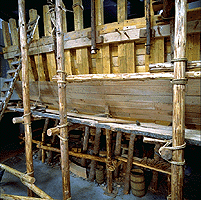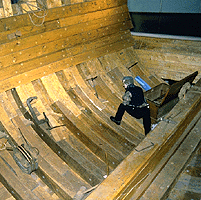Canada Hall
 The Maritime
Shipyard
The Maritime
Shipyard
 The shipbuilding
industry has been active on the east coast
since the early days of settlement. Initially, the boats tended
to be rather small craft used by fishermen and privateers. It was
not until the nineteenth century, with improved technology and
the increased importance of maritime trade, that the production
of bigger and faster ships began. From 1850 to 1870, the period
that is considered Canada's "Golden Age of Sail," the Canadian
merchant sailing fleet grew to be the fourth largest in the
world, behind Great Britain, the United States, and Norway.
The shipbuilding
industry has been active on the east coast
since the early days of settlement. Initially, the boats tended
to be rather small craft used by fishermen and privateers. It was
not until the nineteenth century, with improved technology and
the increased importance of maritime trade, that the production
of bigger and faster ships began. From 1850 to 1870, the period
that is considered Canada's "Golden Age of Sail," the Canadian
merchant sailing fleet grew to be the fourth largest in the
world, behind Great Britain, the United States, and Norway.
 By the second half of the nineteenth century, Canadian ships
were involved in transatlantic trade, carrying domestic goods
such as lumber, fish, agricultural products, tobacco, petroleum,
and manufactured goods, as well as American cotton. Coal, coke,
pig iron, copper, porcelain, and luxury goods were imported from
Africa, the Middle East, and the Orient. Other trade
opportunities resulted from Britain's policy of denying American
ships access to the British West Indies. Thus, Canadian ships
imported valuable exotic wood, coffee, sugar, molasses, and rum
into North America and exported domestic products such as lumber
and dried, smoked or pickled fish.
By the second half of the nineteenth century, Canadian ships
were involved in transatlantic trade, carrying domestic goods
such as lumber, fish, agricultural products, tobacco, petroleum,
and manufactured goods, as well as American cotton. Coal, coke,
pig iron, copper, porcelain, and luxury goods were imported from
Africa, the Middle East, and the Orient. Other trade
opportunities resulted from Britain's policy of denying American
ships access to the British West Indies. Thus, Canadian ships
imported valuable exotic wood, coffee, sugar, molasses, and rum
into North America and exported domestic products such as lumber
and dried, smoked or pickled fish.

The crew of the Agnes Sutherland
The life of a seaman on square-rigged vessels was rugged and hazardous. Seafarers contended with prolonged separation from family, meagre financial rewards and the perils of abduction and desertion. A mariner's life offered adventure, travel and the opportunity for promotion. New crewmen had much to learn and experience before they were able to do their work properly. The isolation and monotony of life at sea as well as its perils and mystery bred a rich folklore amongst the mariners which ultimately pervaded the rest of Maritime society.
The ship under construction in the exhibit is a tern schooner, the type built in Nova Scotia in the 1870s and 1880s. Only a small part of the hull is visible. At this stage of construction, the ship is being ceiled; that is, planking is being added to the interior. To fasten the planks to the hull, holes were bored into the ribs with an auger (a manually operated drill), and large wooden pegs and metal spikes were driven into the holes using a heavy wooden mallet. The gaps between the planks were then filled with oakum, a substance made of hemp fibre and pitch. To apply the oakum, the workers used a caulking mallet and caulking irons that resembled large broad chisels.


Most of the vessels built in Atlantic Canada were made of softwoods such as spruce and white pine. These ships were less durable than the American and British ships made of oak, but they were also less expensive. Between the 1820s and the 1880s, major improvements in shipbuilding almost doubled the lifespan of vessels, making Canadian ships all the more attractive. Shipbuilding provided employment and stimulated the economy by encouraging secondary manufacturing of essential parts.
By the end of the nineteenth century, the Maritime shipbuilding boom ended, as Canada's merchant fleet dropped to tenth position in world importance. The factors that contributed to the demise of the shipbuilding industry are numerous and complex: falling world prices for primary resources, depletion of the original forests, lack of funds to build steel steamships, competition from land-based industries, and government policies that favoured transcontinental trade by rail.

